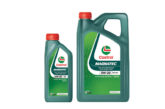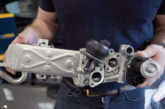Calculating the correct labour rates to ensure a healthy profit is not always a simple process. Andy Savva, former multiple independent garage owner, offers insight into his business model and why it provided the ticket to success.
When independent garage owners are asked, ‘what’s the basis of your labour rate?’, one of the most frequent responses I hear is, ‘it’s the going rate in the area’.
Andy Savva is a former multiple independent garage owner who boasts over 30 years’ experience in the automotive repair sector. In every issue of PMM he’ll be sharing his advice with workshop owners who want to improve their business’ bottom line, but simply don’t know how to go about it.
There is a flaw in this repeated answer. How can you set your labour rate within the same bracket as your competitors? If you do, that tells me that you have the same fixed costs, rent, rates, insurance, electricity, gas, salaries etc. as everyone else – surely this cannot be possible.
Of course it’s not. Yes, independent garage owners will have similar running costs, but not exactly the same, yet labour rates are set on the basis that it’s the going rate within a given postcode. Let me tell you here and now, this is certainly not the way it should be done.
Calculating your labour rate
Your first challenge is to calculate the complete running costs for your business as mentioned earlier, and this should come straight from your annual accounts. Let’s assume, for illustrative purposes, that this figure is £395,000. This includes staff salaries for five technicians and three non-productives, all your rent rates, insurance and general running costs etc.
Let’s say that the garage is open for business 46 weeks per year, factoring in holidays, training and sick days etc. This means that you need to generate an income of £8587 per week (rounded up to the nearest whole number), in order to generate your £395,000 and break even.
At this point I would not consider the additional mark-up of parts, usually around 30 to 40%, as I see this income as a bonus. I always base my business objectives on making my garages sustainable and profitable on labour hours sold.
The next step is to calculate the potential labour hours you have available to you to sell – for example, number of ramps/working bays or number of productives (five ramps/technicians x seven hours per day) multiplied by five days per week for 46 weeks in the year. Stay with me!
So, if we use the calculation above, the potential labour that can be generated will be 175 hours per week, and if we multiply that by 46 weeks we can potentially achieve 8050 labour hours per year.
Now, we already know that we need to generate £395,000 per year to meet our fixed cost expenditure without making a profit. If we then divide the annual running cost, £395,000, by the potential labour hours available, 8050, we get a labour rate of £49 per hour.
Recovery rate
This next bit is an important point: whatever labour rate you set will not necessarily mean that it is what you recover or receive in real terms. In my travels, up and down the country reviewing many different independent garages, I have found that most do not sell more than four hours of labour per technician per day – a low figure which has a dramatic impact on the overall labour rate originally charged.
If your labour rate is, say, £50 and you are paying a technician to be there for eight hours, the labour rate is actually approximately £25 per hour. That’s called a recovery rate. This figure will fluctuate due to many factors, like productivity, utilisation, efficiency of the workshop, types of jobs you undertake, skill level, tooling and equipment that you have, and any discounts and small repairs (bulb changes, lubricant top-ups) that are not charged for.
The way you manage your bookings, workshop loading, and indeed, how good your service reception personnel are, all contribute to the overall recovery of your labour rate.
“I always base my business objectives on making my garages sustainable and profitable on labour hours sold.”
Going the extra mile
Your starting point has now been achieved. The next step is to consider the services your garage offers. Are you a specialist, where you can charge more per hour for that expertise as I did at Brunswick Garage? Or are you an all makes service and repair centre? Whatever you are, you need to align your labour rate accordingly and yes, knowing what your competitors charge is important, but it is not critical.
When I began Brunswick Garage, I knew my labour rate then (£82) would be way above what other independent garages were charging – the average being around £50. This did not bother me at all because I knew that I was offering potential customers a service that no one else could or would match in terms of facilities, skilled staff, OE equipment and tooling. So my labour rate was set to cover these costs and leave me a reasonable profit to keep investing in my business and people.
There are many consumers willing and able to pay that little bit extra as long as they feel they have received value for money, accompanied by an honest and trustworthy service. I did not want to be in the same bracket as every other independent garage business, offering the same services as everyone else and not really offering anything different. To compete like this is much harder, as each business is then trying to attract the same customer, inevitably pushing labour rates down or pushing them up for the wrong reasons.
The other concern I have with our sector, not only independent but retailer (main dealers) as well, is when you see lower labour rates advertised or offered for older vehicles. This drives me mad. Why should we charge less? Is it because some other technician is going to come out of the workshop tooling cupboard who is under-skilled, paid less and only works on older vehicles, meaning that the job is not worth charging the full rate? Of course not! The same technicians with the same level of skill will be the ones working on it, no matter how old the vehicle may be.
I am happy to report that when I sold Brunswick Garage in December 2015, our labour rate was £90 per hour. However, our actual recovery rate was £82 per hour – extremely healthy and unmatched as far as I am aware.
My final comment is this: whatever your labour rate, always remember that even if it’s higher than most, you must be able to justify it if and when questioned by your customers. You must ensure you continually explain the services and products you offer, and learn to communicate the benefits of using your garage rather than that of your competitors.











